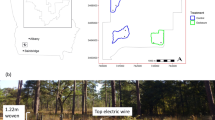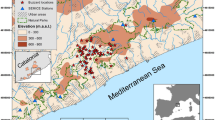Abstract
The small-bird-in-winter paradigm is prominent in the field of behavioral ecology. However, our conceptual understanding of this paradigm is limited by our lack of knowledge about Accipiter hawks. Although Accipiters are the major predators of small wintering birds, we know little about their behavior during the winter. In this paper, we present the first description of the predatory behavior of wintering sharp-shinned hawks (Accipiter striatus), focusing on their selection of prey and attack strategies. We also relate basic prey behavior to the risk of death during an attack. During the winters of 2000–2004, we observed 255 attacks and recovered 112 prey items from 21 intensively radio-tracked hawks. The diet of sharp-shinned hawks in the study was composed primarily of sparrow-sized prey, intermediate-sized starlings (Sturnus vulgaris), American robins (Turdus migratorius), and the occasional larger prey such as mourning doves (Zenaida macroura). Both sexes killed all sizes of prey, although female hawks took significantly more large prey than did males. Small preys under 20 g, such as parids, were largely ignored. This lack of very small prey in the diet of sharp-shinned hawks suggests that we might focus the small-bird-in-winter paradigm on sparrows and intermediate-sized prey, such as robins, as the main prey base of Accipiters at least in North America. In addition, solitary and feeding prey were significantly more likely to be captured during an attack than prey in groups and those not feeding. Our hawk-driven observations provide rare empirical support for the concept that flocking birds are safer than solitary birds and alert birds experience less risk than those preoccupied with feeding.


Similar content being viewed by others
References
Beauchamp G (2003) Group-size effects on vigilance: a search for mechanisms. Behav Processes 63:111–121
Bednekoff PA (1997) Mutualism among safe, selfish sentinels: a dynamic game. Am Nat 150:373–392
Berger DD, Mueller HC (1959) The bal-chatri: a trap for the birds of prey. Bird Band 30:18–26
Bertram BCR (1978) Living in groups: predators and prey. In: Krebs JR, Davies NB (eds) Behavioral ecology: an evolutionary approach. Blackwell, Oxford, UK, pp 279–309
Bibby C J, Burgess ND, Hill DA (1992) Bird census techniques. Academic, London, UK
Bildstein KL, Meyer K (2000) Sharp-shinned hawk (Accipiter striatus). In: Poole A, Gill F. The Birds of North America No. 482. The Academy of Natural Sciences and the American Ornithologists’ Union Philadelphia PA and Washington DC
Cresswell W (1994a) Flocking as an effective anti-predation strategy in redshanks, Tringa totanus. Anim Behav 47:433–442
Cresswell W (1994b) Age-dependent choice of redshank (Tringa totanus) feeding location—profitability or risk. J Anim Ecol 63:589–600
Cresswell W (1996) Surprise as a winter hunting strategy in sparrowhawks Accipiter nisus, peregrines Falco peregrinus, and merlins, F. columbarius. Ibis 138:684–692
Cresswell W, Whitfield P (1994) The effects of raptor predation on wintering wader populations at the Tyninghame estuary, southeast Scotland. Ibis 136:223–232
Cresswell W, Lind J, Kaby U, Quinn JL, Jakobsson S (2003) Does an opportunistic predator preferentially attack nonvigilant prey? Anim Behav 66:643–648
Cuthill IC, Houston AI (1997) Managing time and energy. In: Krebs JR, Davies NB (eds) Behavioral ecology: an evolutionary approach. Blackwell, Oxford, UK, pp 97–120
Dolby AS, Grubb TC (1998) Benefits to satellite members in mixed-species foraging groups: an experimental analysis. Anim Behav 56:501–509
Dolby AS, Grubb TC (2000) Social context affects risk taking by a satellite species in a mixed-species foraging group. Behav Ecol 11:110–114
Dunn EH, Tessaglia DL (1994) Predation of birds at feeders in winter. J Field Ornithol 65:8–16
Dunning JB (1993) CRC handbook of avian body masses. CRC, Boca Raton, FL
Elgar MA (1989) Predator vigilance and group size in mammals and birds: a critical review of the empirical evidence. Biol Rev 64:13–33
Giraldeau L-A, Caraco T (2000) Social foraging theory. Princeton Univ. Press, Princeton, NJ
Gotmark F, Post P (1996) Prey selection by sparrowhawks, Accipiter nisus: relative predation risk for breeding passerine birds in relation to their size, ecology, and behaviour. Royal Soc Lond B 351:1559–1577
Greenberg R (2000) Birds of many feathers: the formation and structure of mixed-species flocks of forest birds. In: Boinski S, Garber PS (eds) On the move: how and why animals travel in groups. Univ. of Chicago Press, Chicago, IL, pp 521–558
Hilton GM, Cresswell W, Ruxton GD (1999) Intraflock variation in the speed of escape–flight response on attack by an avian predator. Behav Ecol 10:391–395
Houston A, McNamara J (1999) Models of adaptive behavior. Cambridge Univ. Press, Cambridge, UK
Kaby U, Lind J (2003) What limits predator detection in blue tits (Parus caeruleus): posture, task, or orientation? Behav Ecol Sociobiol 54:534–538
Krause J, Godin JGJ (1996) Influence of prey foraging posture on flight behavior and predation risk: predators take advantage of unwary prey. Behav Ecol 7:264–271
Lima SL (1985) Maximizing feeding efficiency and minimizing time exposed to predators: a trade-off in the black-capped chickadee. Oecologia 66:60–67
Lima SL (2002) Putting predators back into behavioral predator–prey interactions. Trends Ecol Evol 17:70–75
Lima SL, Zollner PA, Bednekoff PA (1999) Predation, scramble competition, and the vigilance group size effect in the dark-eyed junco (Junco hyemalis). Behav Ecol Sociobiol 46:110–116
Lindstrom A (1989) Finch flock size and risk of hawk predation at a migratory stopover site. Auk 106:225–232
Mangel M, Clark CW (1988) Dynamic modeling in behavioral ecology. Princeton Univ. Press, Princeton, NJ
McNamara JM, Houston AI, Lima SL (1994) Foraging routines of small birds in winter—a theoretical investigation. J Avian Biol 25:287–302
Mitchell WA, Lima SL (2002) Predator–prey shell games: large-scale movement and its implications for decision-making by prey. Oikos 99:249–260
Mueller HC, Berger DD (1970) Prey preferences in the sharp-shinned hawk: the roles of sex, experience, and motivation. Auk 87:452–457
Mueller HC, Mueller NS, Berger DD, Allez G, Robichaud WG, Kaspar JL (2000) Age and sex differences in the size of prey of the sharp-shinned hawk. J Field Ornithol 71:399–408
Newton I (1986) The sparrowhawk. T & AD, Poyser, UK
Pravosudov VV, Grubb TC (1997) Management of fat resources and food caches in tufted titmice (Parus bicolor) in relation to unpredictable food supply. Behav Ecol 8:332–339
Pulliam HR, Caraco T (1984) Living in groups: is there an optimal group size? In: Krebs JR, Davies NB (eds) Behavioural ecology: an evolutionary approach. Blackwell, Oxford, UK, pp 127–147
Rappole JH, Tipton AR (1994) New harness design for attachment of radio transmitters to small passerines. J Field Ornithol 62:335–337
Rosenfield RN, Bielefeldt J (1993) Cooper’s hawk (Accipiter cooperii). In: Poole A, Gill F. The Birds of North America No. 75 The Academy of Natural Sciences and the American Ornithologists’ Union Philadelphia PA and Washington DC
Roth TC, Lima SL (2003) Hunting behavior and diet of Cooper’s hawks: an urban view of the small-bird-in-winter paradigm. Condor 105:474–483
Roth TC, Lima SL, Vetter WE (2005) Survival and causes of mortality in wintering sharp-shinned and Cooper’s hawks. Wilson Bull 117 (3):237–244
Selas V (1993) Selection of avian prey by breeding sparrowhawks, Accipiter nisus, in southern Norway—the importance of size and foraging behavior of prey. Ornis Fenn 70:144–154
Smith SM (1991) The black-capped chickadee: behavioral ecology and natural history. Comstock, Ithaca, NY
SPSS Inc (1998) SYSTAT 9.0 for Windows. SPSS, Chicago, IL
Stephens DW, Krebs JR (1986) Foraging theory. Princeton Univ. Press, Princeton, NJ
Sullivan KA (1984) The advantages of social foraging in downy woodpeckers. Anim Behav 32:16–22
Whitfield DP (1985) Raptor predation on wintering waders in southeast Scotland. Ibis 127:544–558
Whitfield DP, Cresswell W, Ashmole NP, Clark NA, Evans AD (1999) No evidence for sparrowhawk selecting redshanks according to size or condition. J Avian Biol 30:31–39
Wilson JD, Weir AG (1989) Hunting behavior and attack success of a female sparrowhawk between October 1987 and April 1988. Scott Birds 15:126–130
Acknowledgements
We thank our many field technicians for their assistance in tracking hawks. T. Dailey provided expert assistance with point count surveys. We would also like to thank local landowners (especially M. Evrard, J. Irwin, C. Martin, and C. Miller) for their cooperation. W. Cresswell, R. Gibson, J. Lesku, and P. Scott provided helpful comments on drafts of this manuscript. This research was supported in part by the National Science Foundation (Grant IBN-0130758 to SLL), the Indiana Academy of Sciences, and the Department of Ecology and Organismal Biology and School of Graduate Studies at Indiana State University. This research conformed to the guidelines of the Institutional Animal Care and Use Committee at Indiana State University (protocols OO-19:TR/SL and 08-21-2003:TR/SL).
Author information
Authors and Affiliations
Corresponding author
Additional information
Communicated by R. Gibson
Rights and permissions
About this article
Cite this article
Roth, T.C., Lima, S.L. & Vetter, W.E. Determinants of predation risk in small wintering birds: the hawk’s perspective. Behav Ecol Sociobiol 60, 195–204 (2006). https://doi.org/10.1007/s00265-005-0156-y
Received:
Revised:
Accepted:
Published:
Issue Date:
DOI: https://doi.org/10.1007/s00265-005-0156-y




